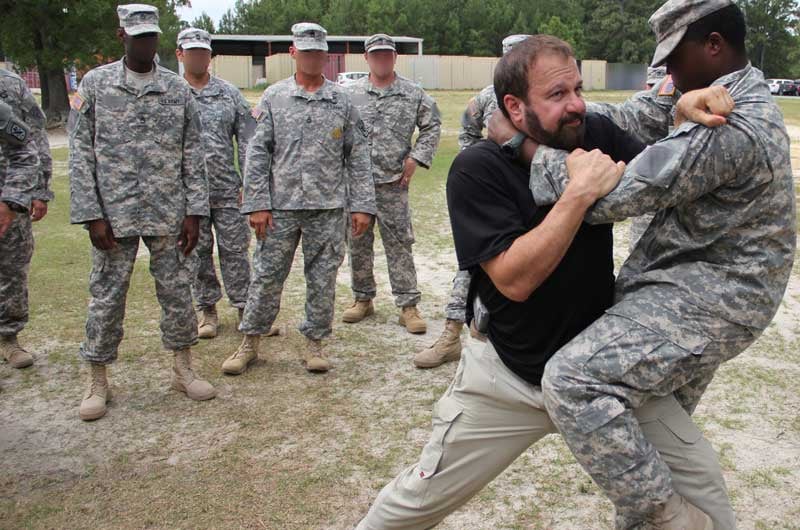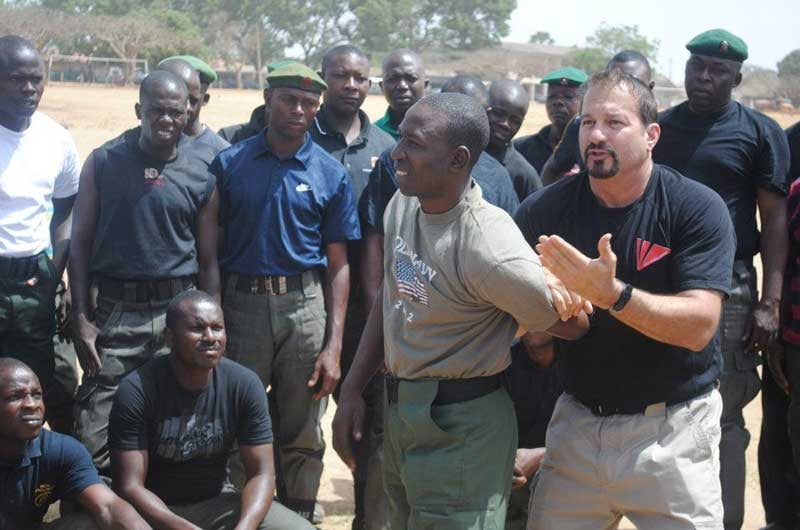Dave Young knows a few things about home defense, after all, he wrote a book on it.
In his book, How to Defend Your Family and Home, Young interviewed more than 100 people who lived through home defense encounters. Young himself also lived through a home defense encounter as a teenager. He used that experience as motivation to make sure no one had to go through what he went through.
Since then Young has become a seasoned Marine veteran, law enforcement officer and now heads Arma Training, one of the nations leading training institutes for military and law enforcement.

Dave Young trains military members some ECQ combat techniques (Photo: Arma Training)
His book goes into great detail about ways in which you can lessen the chances of a home invasion as well as what to do if it occurs. Young spoke to Guns.com about some basic principles and suggestions for home defense. Here are five things you can do to make yourself more secure at home.
Get a Good Layout of Your Property
“We recommend doing property walks that start from the outside of your property, stopping by trees that might block your vision. Stand by a tree and look and see if you see into your window,” Young told us.
The property walk goes far beyond seeing if you have visual impairments. Look around the property for things like impressions you might not recognize. You see a size 14 boot print on your property, but you only wear flipflops? That might be something you pay close attention to. Are there more of them? Where are they leading to?
Other indicators might include things like cigarette butts, food, or garbage. All these could be a telltale sign that someone has been on your property.
Walk the Outside of Your House
“Whether you buy a brand-new house or you’re moving into a used home it’s important to check all the strike plates, the latches and locks that are on the door,” Young said.
In addition to checking these key security staples of the home Young also recommends checking near the door handle and lock for tool marks. If there are tool marks that appear to be old he suggests putting some clear nail polish over it.
“You can see if there’s any fresh tool marks. Sometimes people try to break in your house leave for a variety of reasons,” he said. This may not prevent a future break-in but it will give you some indication that there is something nefarious going on.
Additionally, look for things like cut screens, light bulbs being loose or unscrewed and of course items that do not belong to you.
Walk the Inside of Your House
If you’re worried that someone may be breaking into your home there are a few practical things you can do to confirm suspicions.
“I’ll give an example. When you stand in my doorway and you look throughout the house, you’ll be able to see specific pictures that are facing you. Well, if we walk in the home and I see those pictures are not facing I know someone has been in my home,” said Young.
Leaving certain doors in the house closed at all times when gone is another practical tip that Young gives for telling if someone has been in your home.
“We have five doors down one of our hallways, we leave a specific one closed when we leave. So if it’s open again [when we get home], it’s all to give you indicators that someone has been in your home,” Young told us.
This practice of walking the property, followed by the outside of the home, followed by inside the house should be done at least once a month Young recommends. Besides looking for things that are misplaced or askew in your home you should also be looking for places of engagement or opportunity.
Have a Plan
“You should never have a knee jerk reaction to your own personal safety. That is the silliest thing you can do,” says Young. Your home defense plan should be well thought out and discussed with all family members. It’s important to give everyone who is of age basic training on how to handle, reload and shoot a firearm. It’s equally as important to impart vital first-aid training that could save a life.
You also need to plan and stage your weapons and ammo in a place that will be beneficial for you if a break-in should occur. “Don’t put all your firearms and your ammunition and your magazines right near your bed. Then your out in your hallway or kitchen [and the break-in occurs].
It kind of defeats the purpose of having your equipment,” Young says.
Now he isn’t advocating that you sweep and clear your home every night but having weapons strategically placed is something to think about. You also don’t want to hide them in a place that invokes the ‘whoops I forgot it was there’ mentality. Young has heard stories of people hiding guns in their laundry machines, ovens, flowerpots, etc. These are impractical places to hide a gun as they are either needed for everyday life or would be hard to access in a time of need.
Finally, your plan needs to include communication and verbalization both during the event and afterward as well. Home defense means that you’re committed to keeping family safe, meaning you need to shoot until you stop the threat. Once the threat down, does that mean that you put the gun down? No.
Young suggests you first clear your home to make sure that there is no one else there that could bring harm to your family. After that, you’ll want to call the police to make sure that they are on their way.
When the police arrive, you need to also have a “surrender plan.” They shouldn’t see the gun in your hand. You should have your hands clearly visible when they come into the home and you should follow instructions completely.
“A lot of people aren’t thinking about what happens afterward. They’re thinking if someone comes into my house, I’ll shoot them,” Young said.

Dave Young trains the Nigerian Federal Police Force on some defensive holds. (Photo: Arma Training)
Practice, Practice, Practice
What good is a home defense plan if you never discuss it or practice the fundamentals of what might happen? “We raised five boys and a girl,” Young said, “When they were younger it would be a game. Let’s play hide and seek and let’s get out of the house and hide there. Then when they got older, they understood their roles more.”
As you can tell the Dave Young home defense plan involves a lot more than putting rounds downrange or teaching a family member how to shoot. It’s an all-encompassing view of how you’re going to defend your home but also how you can escape and then what to do after.
“You have to take a look at this thing from A to Z, not something’s happening, and I got to react to it. We’d rather you respond to it, which is a planned sequential event,” said Young.
Conclusion
A home defense plan will be a very personal and unique thing for your family and home. It’s important though to have a pre-planned event in case something happens because a knee jerk reaction is never a good thing.
If you’d like to know more about Dave Young you can check out Arma Training to see his training classes or you can buy his book on Amazon. The book goes deeper and gives some concrete ideas and examples of things you can do to set up a home defense plan for your family. At the end of each chapter is a couple of activities and drills which will allow you to implement what Young is teaching into your home defense plan.
Find the home defense gun you’re looking for by checking Guns.com’s wide selection of Certified Used Guns.
The post 5 Practical Tips for Home Defense to Keep You Safe appeared first on Guns.com.
